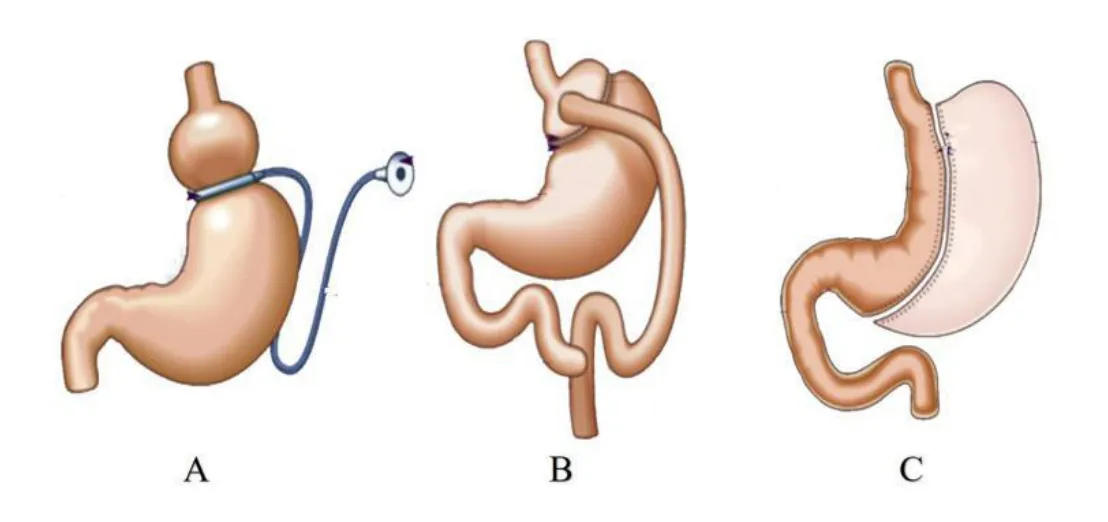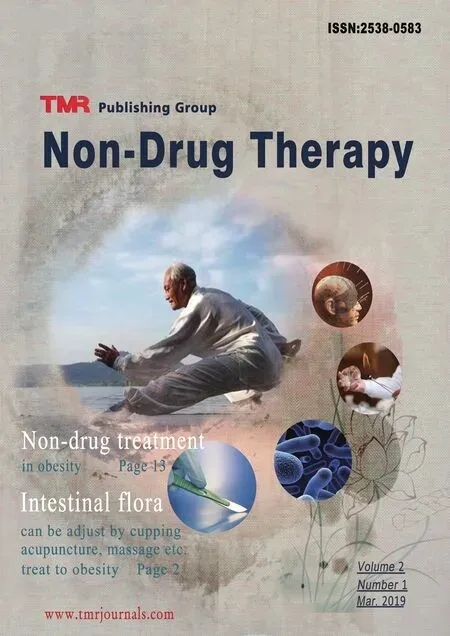Review of the non-drug treatment in obesity
Chang Liu
1Tianjin Medical University Cancer Institute and Hospital,Tianjin,China.
Abstract
Keywords: Obesity,Acupuncture,Exercise,Lifestyle,Surgery,Psychological,NPY,PPY
Introduction
Obesity,which bring a great perplex to family and society,has significant contribution to the risk of diabetes,cardiovascular disease,and other comorbidities such as insulin resistance,dyslipidemia,and hypertension [1,2].In past four decades,the incidence of obesity has been on the alarming rise [3].Obesity now affects about a third of the world's adults,if this trend continues,by 2030,38% of the world's adults will be overweight and 20% will be obese [4].
Obesity was divided into metabolic and hedonic obesity,in other words,food addiction and metabolic diseases are the main causes of obesity [3,5].No matter which type of obesity,medicine intervention often employed to help obese individuals lose weight [6].However,due to the side effects of drugs and high cost,the treatment effect of obesity is not ideal [7].Non-drug treatment for obesity are divided into non-intrusive interventions and intrusive interventions. The non-intrusive interventions recommended in adopting mental imagery,cognitive-behavioural therapy,lifestyle adjustments,diet control,physical exercise,etc.[8-12].Acupuncture,massage,moxibustion,bariatric surgeryetc.belong to the intrusive interventions [13].Compared with drug therapy,non-drug therapy is more convenient,cheaper,safer and more easily accepted by obese people. This article reviews the literature of at home and abroad on non-drug therapies for obesity in recent years,to summarize its non-drug treatment methods and preliminary analysis the mechanism and advantage about these different therapies.Established the status of non-drug therapy to treat obesity.
Acupuncture
Acupuncture and its development of therapies have been used to treat a number of diseases in the Far East for centuries [14].The earliest recorded of acupuncture in China is inZhenjiujiayijing(215-282,A.D.Jin Dynasty),which records the use of acupuncture before Jin dynasty and the experience of acupuncture treatment at that time [15].Acupuncture is one of the oldest healing practices and is recognized by the National Institute of Health and the World Health Organization [16].Along with the development of acupuncture,it developed into auricular acupuncture,electric acupuncture,fire needle,and acupoint embedding.On account of acupuncture convenience operation and less traumatic,so it usually as a complementary therapy for obesity.According to traditional Chinese medicine theory,acupuncture could regulates Qi and blood,it may affect the bioavailability of internal substances.In this process,it may affect absorption,distribution,metabolism and excretion of substances [16,17].
Ghrelin is a novel growth hormone-releasing peptide and an obesity-related peptide hormone,mainly isolated from the stomach [18].It can stimulate the release of growth hormone from the pituitary [18].Moreover,ghrelin also can alter feeding behavior,energy metabolism,and gastrointestinal functions [19-22].In the patients of obesity and metabolic syndrome,the ghrelin levels in their body fluid was lower than healthy crowd [23-25].There are many of studies showed that the increase of the ghrelin has the benefits for obesity [26,27].Hsuet al.use a Randomized Controlled Trial to explored the relationship between the acupuncture and obesity [28].The results showed that the treatment group (auricular acupuncture intervention) revealed a significant increase in ghrelin level compared with control group (placebo needles).Furthermore,acupuncture was also proved that have positively influence in the aspect of serum immunoglobulin levels,glucose and lipid metabolism,and insulin resistance [29-31].
Exercise training
Exercise is the most common treatment for obesity.Exercise training plays a significantly role in improve the body energy metabolism,cardiorespiratory fitness and insulin resistance [32,33].Exercise training include yoga,jogging,swimming and even Chinese Qigong and Taichi.Exercise training can improve the dyslipidemia of obese individuals by restoring the gene expression of fat oxidation and fat production related molecules,to achieve the effects of weight loss [34,35].Obesity is a low-grade inflammation,it may lead to the inflammatory markers such as tumor necrosis factor α,IL-6 and C-reactive protein present abnormal level [36].Some studies found that lower levels of inflammatory cytokines in the blood of individuals who exercised regularly or were in good health compared with those who did not exercise regularly or were in poor health [37,38].Therefore,we hypothesized that exercise could treat obesity by reducing the inflammatory factors associated with obesity.
Toll like receptors (TLRs) is one of the transmembrane receptor and pathogen pattern recognition receptor in innate immune system [39].TLRs participate in the body's immune and inflammatory response [39].TLRs are widely expressed in the body,and TLR4 is the first human TLR discovered.TLR4 could recognizes lipopolysaccharides from the cell walls of gram-negative bacteria and make the body immune in the early invasion of pathogens to start the body's immune response [40].TLR4 has been found in adipose tissue,liver tissue and skeletal muscle tissue,which are closely related to energy metabolism [41,42].The increased infiltration of macrophages in adipose tissue of obese individuals may be an important source of inflammation,at the same time,plasma lipopolysaccharide levels were elevated in obese patients,lipopolysaccharide is the ligand of TLR4,these results suggest that chronic low-grade inflammation in obesity may be related to the activation of TLR4 [43,44].Therefore,decreased TLR4 levels in obese individuals may improve obesity status.There is a mount of research shown that both acute and long-term exercise can reduce the secretion of TLR4 in adipose tissue [45-47].Exercise training can treat obesity by improving inflammation status.
Surgery
Surgical treatment of obesity involves different approaches to the treatment and reconstruction of the gastrointestinal tract.The surgical treatment of obesity began in 1954,since then,many surgical methods have been developed [48].The feasibility of bariatric surgery in adults has been clearly proven [49,50].The most common surgery techniques are gastric band (Figure 1A),gastric bypass (Figure 1B) and sleeve gastrectomy (Figure 1C) [51].It is worth mentioning that gastric band often used to treat mild to moderate morbid obesity,moreover,gastric bypass and sleeve gastrectomy it is commonly used to treat severe morbid obesity [52-54].On the surface,surgery can limit the body's food intake or reduce the absorption of food to prevent further fat gain,at the same time,the life activity of obesity individuals consumes redundant adipose,achieve the goal that reduces weight.However,it may have the further mechanism.

Figure 1 Type of bariatric surgery [51]
Neuropeptide Y (NPY) is a polypeptide which have the effects of increase the dietary intake,brown fat consumption decreased,body fat content increased [55,56].NPY is widely distributed in the central nervous system and peripheral tissues.Peptide YY (PYY) is a hormones that could regulate appetite and widely distributed in gastrointestinal tract,moreover,PYY may play an important function in islet physiology [57].PYY belongs to the neuropeptide Y (NPY) family and have the similar construction with NPY.PYY can enter the nerve center through the blood-brain barrier and specifically bind to the NPY2 receptor,reducing the secretion of NPY and inhibiting feeding [58].After bariatric surgery,there was a significant increase in circulating PYY [59].Hence,obesity surgery can not only reduce fat intake and nutrient absorption,but also inhibit the generation of NPY by increasing the secretion of PYY,so as to achieve weight loss.
Lifestyle intervention and psychological guidance
Interventions for obesity frequently apply change the obesity patients individuals lifestyle [60].Examples include supervised exercise,nonsupervised exercise,occupational activity,healthy diet,personal care,commuting,and leisure time activities [32].Among them,a combination of diet and exercise is the most common treatment for obesity.Carpenter KC conducted Diet control and exercise weight loss among dia-induced Obesity (DIO) mice,DIO mice were divided into voluntary wheel running (VEX),forced treadmill running (FEX),sedentary and control group.After 8 weeks of exercise intervention and low-fat diet intervention,the VEX and FEX groups lost 36% and 27% more weight than the low-fat group,respectively [46].Esposito LM considered that A high-fat diet can induce weight gain and damage the body's immune system [61].In this study,CD-1 mice were randomly divided into diet-induced obesity and sedentary group (DS group),diet-induced obesity exercise group (DE group),and normal obesity sedentary group (NS group).DS group and DE group were fed with 60% fat-energy high-fat feed,while NS group was fed with 10% fat-energy feed.TLR4 expression on the surface of monocytes (CD11b (+) / 14 (+) was observed after 6 weeks.Compared to before the experiment,the expression of TLR4 on the surface of monocytes in DS group was higher than those in NS group and DE group (P< 0.01).These results suggest that exercise can down-regulate the expression of TLR4 in monocytes and inhibit inflammatory immune response to a certain extent in the process of high-fat induced weight gain [61].
In abstractive,the most important intervention of lifestyle in obesity actually depends on psychological factors,such as possessiveness and perseverance.However,the recently researches shown the disadvantage result about the adherence rates [37,62-66].Some adults do not understand the relationship between health and physical activity,they do not believe that effective weight loss leads to the health improved [60].Moreover,they considered that the benefits of healthy is not the motivation to change the lifestyle,only in the process of weight loss doing the exercise [60,67,68].Therefore,breaking down psychological and behavioral barriers to lifestyle treatment of obesity will have a significant effect.Raise awareness of the dangers of obesity among obese people,it's not only when you're obese that you need to have a healthy lifestyle.It is not only obesity that employ a healthy lifestyle,but a healthy lifestyle that should last forever.
Discussion
Since obesity is related to various chronic diseases,such as cardiovascular disease,type 2 diabetes mellitus,some cancers and a wide range of musculoskeletal conditions,and it becomes a major public health problem [69,70].It is no exaggeration to say,obesity even result in psychological and social consequences [71-73].There are many reasons for obesity,however,the mechanism is unclear and many related studies are controversial.The side effects of drug treatment for obesity are obvious,and there is no clear research showing that drug treatment for obesity has long-term effects.Therefore,the non-drug therapy for obesity was most commonly adopted.
For general obesity,choose non-traumatic weight loss methods,such as diet control and exercise intervention.Diet control combine with exercise intervention is a common method for individuals obesity.But there are many obstacles to implementing this treatment.Such as social cues for activity,poor/inconsistent self-monitoring,time management and planning changed,illness,diminished motivation,etc.If you want to remove these obstacles,you should do session for session,repetitive problem-solving and review of self-monitoring skills were the most common lifestyle coaching approaches utilized,not costly incentives [32].Acupuncture is one of the non-drug therapy for obesity.Among the studies on acupuncture treatment of obesity,auricular acupuncture is most commonly used to treat obesity [74,75].It is unclear whether auricular acupuncture is more effective than other acupuncture methods.However,auricular acupuncture as an alternative treatment for obesity deserves further study.
For morbid obesity,surgical intervention is the most effective and direct method.A large number of clinical studies have proved that surgical treatment is the only way to achieve long-term and stable weight loss in morbid obesity.However,although a series of bariatric surgeries have been performed to treat morbid obesity,for a specific patient,how to weigh the advantages and disadvantages of various surgical methods according to their complex physical conditions and help patients choose the most suitable surgical method is a serious problem faced by clinicians.
Conclusion
Non-drug therapy for obesity has great clinical advantages and is worthy of clinical promotion.Though there is amount of non-drug treatments for obesity,the right choice of treatment method is the best way to fight obesity because each body's physical conditions are different.
- TMR Non-Drug Therapy的其它文章
- Brief introduction to the historical development and therapeutic effects of cupping therapy in traditional Chinese medicine
- Progress of research on massage therapy for sub-health conditions
- Effects of comprehensive therapy of traditional Chinese medicine on pneumonia caused by influenza
- Research on the influence of traditional Chinese medicine therapy on the intestinal flora in obese patients
- The influence of traditional Chinese medicine therapy on the intestinal flora in obese patients

